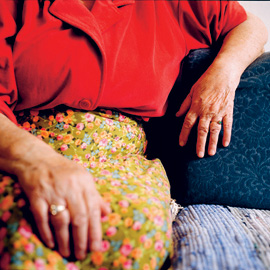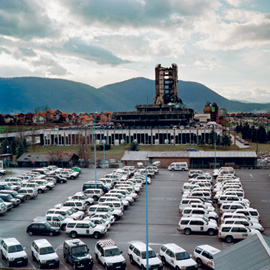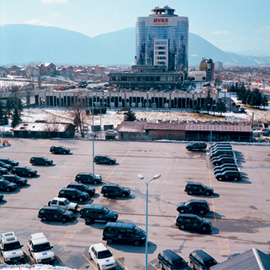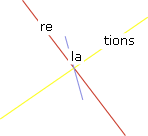|
|
 How to contemplate the present? The very title of the present book describes one precondition for doing so: all of the authors and artists collected here are risking the "leap into the city"— into their own or someone else’s—and marking out standpoints in the here and now. Their texts and images document excerpts from the present; they formulate cultural positions and make political relationships their theme. They have focused rigorously on a reality beyond the spectacular and exotic. Participation—or, perhaps better, contemporaneity— is thus the point of departure of each of the contributions on the following pages. If one claims contemporaneity for oneself, however, as the writer Ulrich Peltzer reminded us not long ago, "one should have at least some sense of the relationships that exist between a permeation of the present with theory and concrete aesthetic practice, between a concept of the world and a reading of it, between that which this reading of the world evokes in terms of affects, astonishment, desperation, hatred, and in some cases even happiness, and the complex interconnection of it in and with a piece of prose."1 To the piece of prose Peltzer mentions can be added the other forms of art that are equally able to convey this idea: namely, an idea that the mechanics of the world are interwoven with a reading of the world. That art, as a possibility for engagement and critique, can also express the effects of a reading of the world. Emotion, empathy, critique, analysis, and aesthetic praxis—these are the threads of our network that connect seven cities and more than fifty authors, artists, and photographers with each other.
How to contemplate the present? The very title of the present book describes one precondition for doing so: all of the authors and artists collected here are risking the "leap into the city"— into their own or someone else’s—and marking out standpoints in the here and now. Their texts and images document excerpts from the present; they formulate cultural positions and make political relationships their theme. They have focused rigorously on a reality beyond the spectacular and exotic. Participation—or, perhaps better, contemporaneity— is thus the point of departure of each of the contributions on the following pages. If one claims contemporaneity for oneself, however, as the writer Ulrich Peltzer reminded us not long ago, "one should have at least some sense of the relationships that exist between a permeation of the present with theory and concrete aesthetic practice, between a concept of the world and a reading of it, between that which this reading of the world evokes in terms of affects, astonishment, desperation, hatred, and in some cases even happiness, and the complex interconnection of it in and with a piece of prose."1 To the piece of prose Peltzer mentions can be added the other forms of art that are equally able to convey this idea: namely, an idea that the mechanics of the world are interwoven with a reading of the world. That art, as a possibility for engagement and critique, can also express the effects of a reading of the world. Emotion, empathy, critique, analysis, and aesthetic praxis—these are the threads of our network that connect seven cities and more than fifty authors, artists, and photographers with each other.
Eastern Europe Is Dead—Long Live Eastern Europe!
Leap into the City does not offer urban portraits in the conventional sense. The capital cities depicted here do not represent "the" eastern European space. The selection of the cities rendered in words and images here follows instead all the cooperative efforts with artists and authors that have developed as part of "relations." "relations" is a project initiated by the German Federal Cultural Foundation that since 2003 has supported artistic and cultural projects in Chişinău, Sofia, Pristina, Sarajevo, Warsaw, Zagreb, and Ljubljana, and sought to connect local contexts to international debates and vice versa. Over the past three years, thirteen projects have resulted in eastern Europe and Germany. The artists and intellectuals who brought these projects to life in cooperation with "relations," their ideas and their positions, are the point of departure, the background, and the point of reference for this publication. Even beyond this simple fact, however, it seemed to us that caution was in order when using collective nouns like "eastern Europe." The complexity and differences of the social situations undermine the utility of terms like these to some degree. For which social condition could possibly form the basis for putting together countries like those of the former Yugoslavia into a single compendium with Poland or Bulgaria? Nevertheless, it would also be wrong to try to remove the term "eastern Europe" from the current debates entirely. This categorization still contours and surveys the field; the term provides readings. The term "eastern Europe" is associated both with a polarization between East and West and with the synthesizing of a geopolitical space. And this double dynamic of locating and drawing borders also establishes one level of argumentation for the present volume, a level that is mirrored or parried by other lines and levels of argumentation. For Leap into the City wishes to capture movements. Movements of thematizing, questioning, critiquing, and perceiving.
What Is an Issue Where?
In the firm conviction that art and culture form the vital center of any society, over the past three years we have repeatedly asked the following questions of artists and theorists: What are the key issues in your city at the moment? What is relevant for you here and now? What vision and what critique have to be brought to a wider audience? What do you want to undertake to these ends and what can you do? Their answers have produced this book— a reader that combines heterogeneous formats of texts and images and that, chapter by chapter, casts spotlights on the local situations, on art and culture, and on critical positions.
We begin with Chişinău, the capital of Moldova, and shed light on what it means to do critical cultural work from the position of a political and cultural outsider. What forms do anger and sarcasm and unshakable self-irony adopt there?
For several years now Sofia has been working on becoming compatible for Europe, and outwardly much has changed. Who are the new owners of the city, and what new visual surfaces and codes do they bring with them?
Kosovo and its capital, Pristina, are marked by uncertainty with regard to their status. Will the vision of independence become reality in 2006? What consequences does freezing a society as a protectorate of the United Nations have for the everyday lives of its members?
 We approach Sarajevo, once battled over so fiercely, roughly ten years after the war, with the questions: What does it mean here to subject the dominant politics of memory to an analysis? Which strategies of visualization come into play? Which do not?
We approach Sarajevo, once battled over so fiercely, roughly ten years after the war, with the questions: What does it mean here to subject the dominant politics of memory to an analysis? Which strategies of visualization come into play? Which do not?
In Zagreb, the capital of neighboring Croatia, intellectuals and artists are reopening the history of their networks: the "second life of the collective" is a response to new conditions that are determined by nationalism and capitalism. What potential for resistance do present collectives and networks develop?
Poland’s capital is booming. At the same time, a critique of neoliberalism is becoming more acute in Warsaw today. How does critical contemporary art relate to trends toward traditionalizing society once again while at the same time urban life is being liberalized, and not least on the basis of the new freedoms that have resulted from the economic upturn?
The citizens of Ljubljana have long since associated themselves with an international network and an unusually lively art and cultural scene. Faced with a changing political and economic situation, however, intellectuals and artists are debating over how to preserve this openness. How do they formulate their critique? Which countermovements do they address? What does internationality mean in Ljubljana today?
The thematic approach the artists and authors have opened up to each city is closely linked to the relevant local context but at the same time points beyond municipal and national borders. In that sense, one question remains consistent throughout: What do these cities and their inhabitants tell us about themselves and also about ourselves? In order to do justice to the heterogeneity of these places and positions, we decided to follow a strict dramaturgy. For each chapter we invited artists and photographers to produce works especially for this publication. In the present volume, the path into the city and to a theme always goes by way of art. In each case, we spoke with writers, curators, journalists, economists, and sociologists. The first essay in each chapter outlines the city’s theme from an internal perspective. It is accompanied by photographic works or visual contributions by artists. A second, briefer contribution takes up a thematic aspect and offers greater depth. It is followed by a reportage, a literary text, or a hybrid of the two, usually formulated from an external perspective. The alternation and confrontation of internal perspective and external view runs through the entire book and is continued in conversations between artists and intellectuals. Members of the "relations" projects discussed with their colleagues in order to make various positions more tangible through dialogue and thereby open them up to negotiation. Before we depart each city and its scenes again, an artistic work visualizes it one more time. Finally, an essay places the local situation in a larger discursive context: How are the new elites coming to terms with the wars of the recent past? Who is turning the communist era into a museum? How is the European Union securing its external borders, and who does the protectorate in the former Yugoslavia really protect?
The chapters on the cities are followed by the "Atlas." Every present has its backdrops and prehistory. We are led through these by a text that sketches in compact form the relationships in realpolitik and weaves in historical and economic data. The tension between subjective perspective and transnational view plays an important role in the "Atlas" as well. Rather than seemingly objective data, it offers a narrative that is founded on facts. At the end of the book we return to the beginning—that is, to the art and culture projects that were developed over the past three years in the framework of "relations." These projects are documented in brief descriptions and lists of all the participants.
The present volume is a collaborative work that can only have been produced through intense cooperation among the members of the "relations" projects; the authors and artists; the advisory team of Marius Babias, Mathias Greffrath, and Georg Schöllhammer; and the editors and translators. And it required not only energy and patience—even finding a language as such was a repeated challenge to our powers of invention. The experiment of cultural exchange and translation, the verbal probing, questioning, and testing, began anew with nearly every initial context, nearly every conversation, and it continued in intense work on the texts. For example, the present contributions were translated from eight languages to produce both an English and a German edition.
 We need only recall briefly here that official wordings and translations frequently become political issues as well; every translation inscribes, consciously or unconsciously, one’s own cultural background. And, as always, the devil is in the details. The explosive force of official wordings can be seen, for example, in the spelling of the name of the city of Pristina. The editors here have followed the international convention that adopts neither the Albanian spelling ( Prishtina ) nor the Serbian one ( Priština ), but rather creates its own: Pristina. Our Kosovar colleagues, speaking Albanian, by contrast, use the Albanian spelling Prishtina. Kosovo belongs to the state union Serbia and Montenegro, even if Kosovar self-conception has produced a clear vote for independence. The presence or nonpresence of the h in Pristina thus narrates the complex history of a conflict over the status of Kosovar society that is still unresolved. For that reason, we decided against standardization, as in other cases as well, and tried to portray the naming practices currently in use.
We need only recall briefly here that official wordings and translations frequently become political issues as well; every translation inscribes, consciously or unconsciously, one’s own cultural background. And, as always, the devil is in the details. The explosive force of official wordings can be seen, for example, in the spelling of the name of the city of Pristina. The editors here have followed the international convention that adopts neither the Albanian spelling ( Prishtina ) nor the Serbian one ( Priština ), but rather creates its own: Pristina. Our Kosovar colleagues, speaking Albanian, by contrast, use the Albanian spelling Prishtina. Kosovo belongs to the state union Serbia and Montenegro, even if Kosovar self-conception has produced a clear vote for independence. The presence or nonpresence of the h in Pristina thus narrates the complex history of a conflict over the status of Kosovar society that is still unresolved. For that reason, we decided against standardization, as in other cases as well, and tried to portray the naming practices currently in use.
Taking into account and in some cases also defending heterogeneity frequently affects literally every word in this book. Allow yourself to be confused. And allow yourself to be seduced—by an incomplete, dialogical, kaleidoscopic attempt to come to terms between the covers of one book with site-specific and yet cross-border questions, with subjectivities, regimes of the gaze and visual axes, official wordings and visual worlds, all of which are in motion. We always understood that one key prerequisite for such an attempt to visualize and convey rested in the interlocking of internal and external perspectives and in establishing distance within empathy. For us, readings that presume a tension between inside and outside and are able to alternate between empathy and distance offer a possibility for participation or, perhaps more accurately, for contemporaneity.
Katrin Klingan and Ines Kappert, Editors
1 Ulrich Peltzer, "Erzählen ohne Grenzen: Kartographien des Romans," unpublished typescript of a lecture held on November 22, 2005, at the Literarisches Colloquium Berlin.
Images from Leap into the City (Selection): Ziyah Gafic', photographs, 2001-2004, Bosnia and Herzegovina
